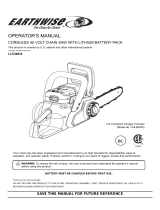
7
ENGLISH
Kickback Safety Features
WARNING: The following features are included on your
saw to help reduce the hazard of kickback; however such
features will not totally eliminate this dangerous reaction.
As a chain saw user do not rely only on safety devices.
You must follow all safety precautions, instructions, and
maintenance in this manual to help avoid kickback and
other forces which can result in seriousinjury.
• Reduced-Kickback Guide Bar, designed with a small radius
tip which reduces the size of the kickback danger zone on
bar tip. A reduced - kickback guide bar is one which has
been demonstrated to significantly reduce the number and
seriousness of kickbacks when tested in accordance with safety
requirements for electric chainsaws.
• Low-Kickback Chain, designed with a contoured depth gauge and
guard link which deflect kickback force and allow wood to gradually
ride into the cutter.
• Do not operate chain saw while in a tree, on a ladder, on a
scaffold, or from any unstablesurface.
• Hold tool by insulated gripping surfaces when performing an
operation where the cutting tool may contact hidden wiring.
Contact with a “live” wire will make exposed metal parts of the
tool “live” and shock theoperator.
• Do not attempt operations beyond your capacity or
experience. Read thoroughly and understand completely all
instructions in thismanual.
• Before you start chain saw, make sure saw chain is not
contacting anyobject.
• Do not operate a chain saw with one hand! Serious injury to the
operator, helpers, or bystanders may result from one handed
operation. A chain saw is intended for two-handed useonly.
• Keep the handles dry, clean, and free of oil orgrease.
• Do not allow dirt, debris, or sawdust to build up on the motor
or outside airvents.
• Stop the chain saw before setting itdown.
• Do not cut vines and/or small underbrush.
• Use extreme caution when cutting small size brush and
saplings because slender material may catch the saw chain
and be whipped toward you or pull you offbalance.
WARNING: Some dust created by power sanding, sawing,
grinding, drilling, and other construction activities contains
chemicals known to the State of California to cause cancer,
birth defects or other reproductive harm. Some examples of
these chemicals are:
• lead from lead-based paints,
• crystalline silica from bricks and cement and other
masonry products, and
• a
rsenic and chromium from chemically-treatedlumber.
Your risk from these exposures varies, depending on how often you
do this type of work. To reduce your exposure to these chemicals:
work in a well ventilated area, and work with approved safety
equipment, such as those dust masks that are specially designed
to filter out microscopicparticles.
• Avoid prolonged contact with dust from power sanding,
sawing, grinding, drilling, and other construction activities.
Wear protective clothing and wash exposed areas with soap
and water. Allowing dust to get into your mouth, eyes, or lay
on the skin may promote absorption of harmfulchemicals.
WARNING: Use of this tool can generate and/or disburse
dust, which may cause serious and permanent respiratory
or other injury.
Chainsaw Names and Terms
• Bucking - The process of cross cutting a felled tree or log intolengths.
• Motor Brake - A device used to stop the saw chain when the
trigger isreleased.
• Chain Saw Powerhead - A chain saw without the saw chain
and guidebar.
• Drive Sprocket or Sprocket - The toothed part that drives the
sawchain.
• Felling - The process of cutting down atree.
• Felling Back Cut - The final cut in a tree felling operation made
on the opposite side of the tree from the notchingcut.
• Front Handle - The support handle located at or toward the
front of the chainsaw.
• Front Hand Guard - A structural barrier between the front
handle of a chain saw and the guide bar, typically located
close to the hand position on the fronthandle.
• Guide Bar - A solid railed structure that supports and guides
the sawchain.
• Guide Bar Scabbard - Enclosure fitted over guide bar to prevent
tooth contact when saw is not inuse.
• Kickback - The backward or upward motion, or both of the guide
bar occurring when the saw chain near the nose of the top area
of the guide bar contacts any object such as a log or branch, or
when the wood closes in and pinches the saw chain in thecut.
• Kickback, Pinch - The rapid pushback of the saw which can
occur when the wood closes in and pinches the moving saw
chain in the cut along the top of the guidebar.
• Kickback, Rotational - The rapid upward and backward
motion of the saw which can occur when the moving saw
chain near the upper portion of the tip of the guide bar
contacts an object, such as a log orbranch.
• Limbing - Removing the branches from a fallen tree
• Low-Kickback Chain - A chain that reduces the kickback
performance requirements. (when tested on a representative
sample of chain saws.)
• Normal Cutting Position - Those positions assumed in
performing the bucking and fellingcuts.
• Notching Undercut - A notch cut in a tree that directs the tree’sfall.
• Rear Handle - The support handle located at or toward the rear
of thesaw.
• Reduced Kickback Guide Bar - A guide bar which has been
demonstrated to reduce kickbacksignificantly.
• Replacement Saw Chain - A chain that reduces the kickback
performance requirements when tested with specific
chainsaws.
• Saw Chain - A loop of chain having cutting teeth, that cut the
wood,and that is driven by the motor and is supported by the
guidebar.




















